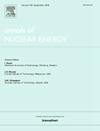验证nTRACER/CTF代码系统的全核心高分辨率循环分析与经合组织/NEA TVA瓦氏棒单元1基准
IF 1.9
3区 工程技术
Q1 NUCLEAR SCIENCE & TECHNOLOGY
引用次数: 0
摘要
本研究旨在开发和验证多物理场高分辨率耦合编码系统nTRACER/CTF,用于笛卡尔几何的全岩心耗尽计算。验证是在OECD/NEA TVA Watts Bar 1基准(TVA WB1)的基础上进行的,使用了来自反应堆应用虚拟环境(VERA)的多物理场高分辨率结果,其中包括MPACT和CTF。本文介绍了基于笛卡尔几何的压水堆耗损计算的nTRACER/CTF耦合系统的发展。在第一个循环开始时的热零功率条件(HZP)和TVA WB1的热零功率情况下验证了nTRACER/CTF模型。两种情况下,临界硼浓度(CBC)差异均小于17ppm,而引脚方向功率分布的均方根差异均小于0.7%。nTRACER/CTF和VERA模型之间差异的影响也被量化。根据基准规范中给出的简化功率曲线,对TVA WB1的整个第一个周期进行nTRACER/CTF耗尽计算。在循环的每个燃耗阶段,用VERA结果对系统进行了验证,包括CBC、轴向平均引脚功率分布、出口温度分布和轴向功率分布。达到全功率状态后CBC差值的均方根值为25ppm。引脚方向功率和出口温度分布的均差小于1.12%和0.4°C,在所有耗尽步骤的1.5%和2°C的目标精度范围内。本文章由计算机程序翻译,如有差异,请以英文原文为准。
Verification of the nTRACER/CTF code system for full core high resolution cycle analysis with the OECD/NEA TVA Watts Bar Unit 1 benchmark
This study aims to develop and verify the multi-physics high-resolution coupled code system nTRACER/CTF for full core depletion calculations in Cartesian geometry. The verifications are conducted on the basis of the OECD/NEA TVA Watts Bar 1 benchmark (TVA WB1), using multi-physics high-resolution results from the Virtual Environment for Reactor Applications (VERA), which includes MPACT and CTF. The paper presents the development of the nTRACER/CTF coupled system for depletion calculations in PWRs, which are based on the Cartesian geometry. The nTRACER/CTF model is verified under the Hot Zero Power Condition (HZP) at the beginning of the first cycle and the HFP case of TVA WB1. The Critical Boron Concentration (CBC) differences are less than 17 ppm in both cases, while the RMS differences in pin-wise power distributions are less than 0.7 % in both cases. The impacts of discrepancies between the nTRACER/CTF and VERA models are also quantified. nTRACER/CTF depletion calculations are performed for the full first cycle of TVA WB1 according to the simplified power curve presented in the benchmark specifications. The system is verified with VERA results for every burnup step of the cycle, in terms of CBC, axially averaged pin power distribution, outlet temperature distribution and axial power profile. The RMS of CBC differences after achieving a full power condition is 25 ppm. The RMS differences in pin-wise power and outlet temperature distributions are less than 1.12 % and 0.4 °C, which are within the target accuracies of 1.5 % and 2 °C for all depletion steps.
求助全文
通过发布文献求助,成功后即可免费获取论文全文。
去求助
来源期刊

Annals of Nuclear Energy
工程技术-核科学技术
CiteScore
4.30
自引率
21.10%
发文量
632
审稿时长
7.3 months
期刊介绍:
Annals of Nuclear Energy provides an international medium for the communication of original research, ideas and developments in all areas of the field of nuclear energy science and technology. Its scope embraces nuclear fuel reserves, fuel cycles and cost, materials, processing, system and component technology (fission only), design and optimization, direct conversion of nuclear energy sources, environmental control, reactor physics, heat transfer and fluid dynamics, structural analysis, fuel management, future developments, nuclear fuel and safety, nuclear aerosol, neutron physics, computer technology (both software and hardware), risk assessment, radioactive waste disposal and reactor thermal hydraulics. Papers submitted to Annals need to demonstrate a clear link to nuclear power generation/nuclear engineering. Papers which deal with pure nuclear physics, pure health physics, imaging, or attenuation and shielding properties of concretes and various geological materials are not within the scope of the journal. Also, papers that deal with policy or economics are not within the scope of the journal.
 求助内容:
求助内容: 应助结果提醒方式:
应助结果提醒方式:


